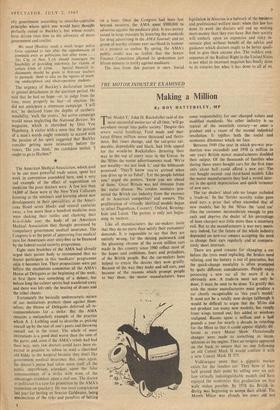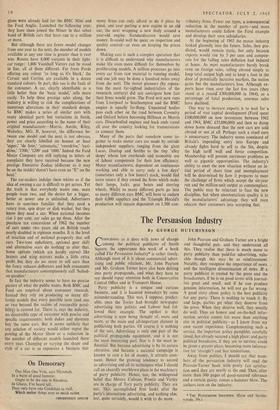THE MOTOR INDUSTRY EXAMINED
Making a Million
By ROY HATTERSLEY, MP THE Model-T,' John D. Rockefeller said of the most successful motor-car of all time, 'will go anywhere except into polite society.' Despite this severe social handicap, Ford made and mar- keted fifteen million seven thousand and thirty- three. But times change, and the cut-price car, durable, dependable' and black, 'had little appeal for the would-be Rockefellers thrusting their way to the top of every state in the Union. In the 'fifties the motor advertisements read, 'We're not wealthy—we just look it,' and the billboards promised, 'They'll know you've arrived when you drive up in an Edsel'; 'Let the people behind you,' urged the posters, 'know you are ahead of them.' Great Britain was not immune from the status disease. No cordon sanitaire pro- tected the British car industry from the excesses of its American competitors and owners. The proliferation of virtually identical models began to infect Dagenham, Coventry, Oxford, Birming- ham and Luton. The patient is only just begin- ning to recover.
Like all manufacturers the car-makers insist that they do no more than satisfy their customers' demands. It is impossible to say that they are entirely wrong, for the shining paintwork and the gleaming chrome of the seven million cars made in this country since 1960 reflect most of the hopes and ambitions, fears and prejudices, of the British people. But the car-makers have helped to create the desires they now gratify. Because of the way they make and sell cars, and because of the reasons which prompt people to buy them, the motor manufacturers have some responsibility for our changed values and modified standards. No other industry is so typical of the twentieth century—at once a product and a cause of the second industrial revolution. It typifies both the social and economic dilemmas which we face.
Between 1949 (the year in which pre-war pro- duction was exceeded) and 1958 (a million in one year) British motor manufacturers doubled their output. Of the thousands of families who during those years bought cars for the first time only about half could afford a new car. The rest bought second- and third-hand models. Like the motor manufacturers they had a vested inter- est in the quick depreciation and quick turnover of new cars.
The car dealers' ideal sale no longer included a `trade-in.' In the 'forties scarcity value gave used cars a price that often exceeded that of new models, but by the 'fifties the 'used car' (like the customer inconsiderate enough to pay cash and deprive the dealer of his percentage of loan charges) was little more than a necessary evil. But to the manufacturers it was very neces- sary indeed, for the future of the whole industry depended on new-car owners accepting the need to change their cars regularly and at compara- tively short intervals.
There are good reasons for changing a car before the tyres need replacing, the brakes need relining, and the battery is out of guarantee, but the quick-change mentality is often prompted by quite different considerations. People enjoy possessing a new car all the more if it is obviously new. A trade-in must not only be done, it must be seen to be done. To gratify this wish the motor manufacturers must produce a car clearly recognisable as 'this year's model.' It need not be a totally new design (although it would be difficult to argue that the 'fifties did not produce too many new models), but simply front wings turned out, fins added or windows realigned. Rootes spent a million and a half pounds a year for nearly a decade in retooling for the Minx so that it could appear slightly dif- ferent at every Motor Show. Occasionally changes were made to something as incon- spicuous as the engine. Then an insignia appeared on the back to ensure that no one following an old Consul Mark II would confuse it with a new Consul Mark II 375.
Volkswagen insist that a gigantic market exists for the timeless car. They have at least half proved their point by selling over six mil- lion virtually indistinguishable models and have enjoyed the economies that production on that scale makes possible. By 1958 the British in- dustry was beginning to accept their diktai. The Morris Minor was already ten years old and plans were already laid for the BMC Mini and The Ford Anglia. Launched the following year, they have since joined the Minor in that select band of British cars that have run to a million or more.
But although there are fewer model changes from one year to the next, the number of models available at any one time is greater than it ever was. Rootes have 8,000 variants in their light- car range: 1,800 Vauxhall Victors can be stood in line, all of them different. Far from Fords offering any colour 'as long as it's black,' the Corsair and Cortina are available in a dozen standard colours. In part, this too is the fault of the consumer. A car, clearly identifiable as a little better than the 'basic model,' sells more easily. To help these prestige sales along, the industry is willing to risk the complications of numerous alterations in their standard design. So BMC makes a series of similar cars with many identical parts but variations in finish, power and price according to the name of their original manufacturer—Morris, Austin, Riley, Wolseley, MG. If, however, the difference be- tween one model and the next is not obvious, they are clearly labelled on bonnet or boot 'super,' de luxe,' automatic,"overdrive,"easi- drive,"1500,"1200' and '1000.' Indeed the Ford Motor Company are still replying to letters of complaint they have received because the new prestige Executive Zodiac (different as it may be on the inside) 'doesn't have even an "E" on the boot.'
The car-makers indulge these whims as if the idea of owning a car is difficult to get across. Yet the truth is that everybody wants one, most people want two, and the desire for a bigger, better or newer one is unlimited. Advertisers have to convince families that they need a rotary iron, spin dryer or dish washer, but they know they need a car. When national incomes rise 1 per cent, car sales go up three. After the purchase tax concessions of 1962 the number of cars under two years old on British roads nearly doubled in eighteen months. It is the level of taxation and of national prosperity that sell cars. Two-tone upholstery, optional gear shift and alternative seats do nothing to alter that. Some options (which are hardly extras) like heaters and wing mirrors make a little extra profit but they do no more to sell cars than the fancy exhaust deflectors and hub ornaments that manufacturers contemptuously call 'bolted- on goodies.'
In fact the industry seems to have no precise picture of what the public wants. Both BMC and Ford are sceptical about consumer research. Instead they rely on producing so many dif- ferent models that every possible taste (and one or two beyond the realms of reasonable possi- bility) is catered for. There is, says the industry, no discernible type of customer with precise and specific requirements; both dukes and dustmen buy the same cars. But it seems unlikely that any echelon of society would either regret the passing of the Motor Show or a reduction in the number of different models launched there every year. Changing or varying the shape and style of a car is so expensive a business that many firms can only afford to do it piece by piece, one year putting a new engine in an old car, the next wrapping a new body around a year-old engine. Standardisation would save money. It could well be spent on inspection and quality control—or even on keeping the prices down.
Making cars is such a complex operation that it is difficult to understand why manufacturers make life even more difficult for themselves by proliferating models. A million processes go into every car from raw material to running model, and one job may be done a hundred miles away from the next. The motor pioneers (by reputa- tion the most far-sighted industrialists of the twentieth century) did not anticipate how fast their firms would grow. The Ford writ now runs from Liverpool to Southampton and the BMC empire is equally far-flung. Unpainted' bodies pass each other on the road between Coventry and Oxford before becoming Hillman or Morris cars. Disembodied engines and back ends travel all over the country looking for transmissions to connect them.
Many of the parts that somehow come to- gether to make motor cars are made by outside independent suppliers, ranging from the giant Lucas, Dunlop and Smiths to the tiny 'alley shops' whose low overheads and economic use of labour compensate for their low efficiency. Motor manufacturers, dependent on continuous working and able to carry only a few days' (sometimes only a few hours') stock, would feel 'more secure if they owned the firms which make their lamps, locks, gear boxes and steering wheels. Whilst so many different parts go into so many, different cars BMC will have to endure their 6,000 suppliers and the Triumph Herald's production will remain dependent on 1,500 con- tributory firms. Fewer car types, a consequential reduction in the number of parts—and more manufacturers could follow the Ford example and develop their own subsidiaries.
At the beginning of 1965 the motor industry looked gloomily into the future. Sales, they pre- dicted, would remain static, but only because exports would rise by 5 per cent and compen- sate for the falling sales deflation had induced at home. As most manufacturers barely break even on foreign sales, sellinf abroad simply to keep total output high and to keep a foot in the door of potentially lucrative markets, the nation gains but the manufacturers lose. Although ex- ports have risen over the last five years (they stood at a record £300,000,000 in 1964), as a percentage of total production, overseas sales have declined.
One way to increase exports is to wait for a period of vast capital development (Ford spent £100,000,000 on new investment between 1962 and 1964, BMC £55,000,000) and then so damp down home demand that the new cars are sold abroad or not at all. Perhaps such a cruel cure is unnecessary. The industry seems convinced of Britain's impending entry into Europe and already fights hard to sell to the Six, despite the high tariff wall and fierce competition. Membership will present enormous problems as well as gigantic opportunities. The industry's ability to meet the new situation without an in- itial period of short • time and unemployment will be determined by how it prepares to meet the challenge of firms which accept the six-year run and the million-unit output as commonplace. The public may be reluctant to face the new discipline, but when unostentatious quality is to the manufacturers' advantage they will even educate their customers into accepting that.











































 Previous page
Previous page